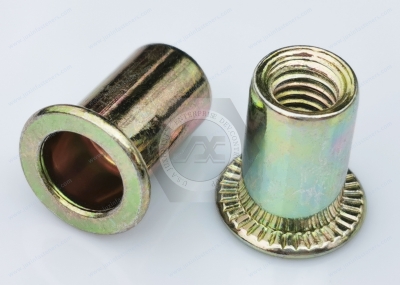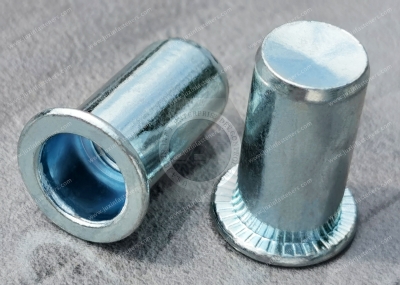Call Us
+86 136 6007 9809
Call Us
+86 136 6007 9809
Feb. 06, 2024
What is riveting? How many classifications of riveted joints are there?
What are the characteristics and application range of each type of riveted joint?
Characteristics and application range of various riveting connection methods
1. Ordinary riveting: The ordinary riveting process is a relatively simple, mature method with stable and reliable connection strength and a wide range of applications. Connected parts deform heavily.
Ordinary riveting is widely used in a variety of components and parts of the body, including semi-circular head flat conical head rivets used for internal body mechanisms and pneumatic profile requirements of the low skin, countersunk head riveting is mainly used for pneumatic profile requirements of the high skin, large flat round head rivets used for the low pneumatic profile requirements of the skin and the tank compartment and other parts of the riveting process.
2. Sealed riveting: sealed riveting is characterized by eliminating structural gaps and blocking the leakage path. The process is more complex; the sealing material should be laid in a specific construction temperature, humidity, and other environments and used according to the closed requirements of the parts and structures in the overall fuel tank and airtight cockpit.
3. Special riveting: Riveting is highly efficient and simple to operate, and it can adapt to the unique requirements of the structure. However, rivet structures are more complex, and there are high manufacturing costs and a narrower range of applications. Riveting failure is not easy to eliminate, so it is used in parts of the structure with special requirements, as well as for repair and troubleshooting.
4. Interference with Long fatigue life can play a sealing role in the nail hole and radically improve the quality of riveted joints. However, the rivet hole precision requirements are high, as it is riveted before the nail and the hole with the strict gap requirements. They are used for increased fatigue resistance or sealing requirements of components and parts.
5. Hand riveting method: simple tools, easy to operate, low efficiency. They are sometimes used for small groups, pallet nuts, and double-sided countersunk head riveting.
6. Impact riveting method: This method is applicable to a variety of riveted structures, including closed, more complex structures. Riveted fashion accessories can be in a variety of positions and states; compared with pressure riveting, it has poor quality stability, low efficiency, and noise. It is used for ordinary riveting, upsetting ring groove riveting, and disquieting riveting, such as high shear resistance riveting.
7. Positive riveting method: compared with the reverse riveting method, riveting deformation is small, skin surface quality, labor intensity, low efficiency, and the scope of application by the structure of the limitations.
For skin surface quality requirements of high countersunk head riveting and ordinary rivets interference with riveting.
8. Reverse riveting method: It has a wide range of applications. The light top handle (relative to the quality of positive riveting top handle) can make the parts tight. Riveting deformation is extensive and severe when the rivet head is around the local subsidence. It is mainly applicable to the structure, not open parts, and coated sealant sealing riveting.
9. The pull riveting method is a simple operation with high efficiency but unstable riveting quality. Used for pull riveting type ring groove riveting, threaded core riveting, high shear riveting, threaded hollow riveting, removing type core riveting, double drum type core riveting, and another single drum type riveting.
10. Pressure riveting method: nail rod can be more uniform upsetting and fill the nail holes, stable quality, good surface quality, high efficiency, good labor conditions, the scope of application by the structural limitations due to the portable riveting machine and riveting mold continued to improve, the scope of its application in the continuous expansion. They were used for open components (such as ribs, frames, beams, siding, etc.) of the flat cone head riveting and countersunk head riveting.
11. Automatic drilling and riveting method: high riveting quality, high efficiency, good labor conditions, complex equipment, expensive. Suitable for headless riveting interference with riveting, upsetting riveting type ring groove riveting, riveting core-pulling rivets. It is also used for ordinary riveting.


12. Stress wave riveting method: the riveting process of riveting material to all directions of synchronous flow, that is, the rivet hole de-filling and rivet upsetting the formation of synchronous completion, and thus can form a relatively uniform amount of interference. Its fatigue life is comparable to or higher than riveting with a headless rivets interference fit. Riveting without finishing holes and a large cargo riveting machine, workpiece deformation is small. However, the equipment is complex, has a short life, is noisy, and the application is not convenient enough. Hand riveting makes it more challenging to form titanium alloys, high-temperature alloys, alloy steel rivets, and large-diameter rivets; riveting carbon fiber epoxy composite materials can also be used for high fatigue resistance requirements of interference with riveting.
13. Hot riveting method: upsetting, easy to form, not easy to produce cracks, better than cold riveting quality, tools, and equipment more complex. For titanium alloy rivets riveting.
Please get in touch with us if you want high-quality stainless steel, the same Canadian blind rivet, or technical support for structural design. Thanks.Email:adelajonly@gmail.com
Website: https://www.juxinfasteners.com
Contact Us
Tel.:
+86 020 8621 0320
+86 020 3121 6067
Technical Support:
Navigation
SEND INQUIREY